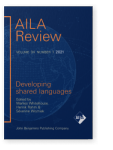Transdisciplinarity in Japanese business communication
New directions for collaboration between professors and professionals
Transdisciplinary collaboration has become one of the most important agendas in the field of Applied Linguistics and professional communication. Investigation into transdisciplinary collaboration has been conducted at the interface of both fields through knowledge transformation and multimethod action research. In Japan, however, investigation into transdisciplinary collaboration or transdisciplinarity still holds great potential for development. As the first step to investigate transdisciplinary collaboration, the author conducted in-depth interviews with eight Japanese business professionals who are also engaged in academic collaboration. The purpose of this study is to understand the challenges and opportunities they are currently facing in transdisciplinary collaboration and to identify shared goals that both applied linguists (academics) and business professionals can explore by focusing on shared language and knowledge transformation in business practice. The whole interview data were analysed using the Modified Grounded Theory Approach (M-GTA) (
Kinoshita, 2003), in which nine basic concepts were obtained in the Open Coding Stage. These were then categorised into four larger groups in the Selective Coding Stage: (1) the current barriers for transdisciplinarity, (2) integration of theory and practice, (3) sensitivity to common ground, and (4) contribution to Japanese society. After presenting these concepts, the construction of shared language as a theme of collaboration is highlighted in the Discussion section.
Article outline
-
1.Introduction
- 2.Literature review
- 2.1Transdisciplinarity
- 2.2Context and common ground
- 2.3Reasons for slowing down industry-government-academia collaboration in Japan
- 2.4Summary of previous studies
- 3.Methodology
- 3.1Research questions
- 3.2In-depth interviews
- 3.3Research participants
- 3.4Method of analysis
- 4.Results
- 4.1Open coding
- 4.2Selective coding
- 4.3Answers to research questions
- 5.Discussion
- 5.1Barriers on the corporate side, on the academic side, and gaps between the two for transdisciplinary collaborations
- 5.2Creating shared language
- 6.Conclusion
- Note
-
References
